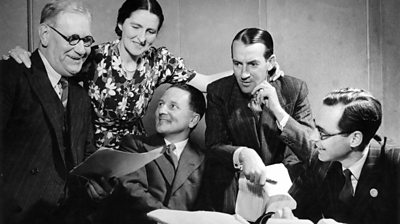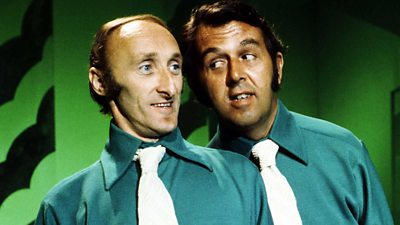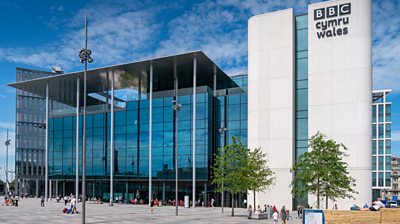On the 100th anniversary of the ±«Óãtv in Wales, Archivist Dr Emma Lile takes a look through the archive collections and shows how they have charted the rich tapestry of Welsh life over time.
Early days
With audio and video now so readily available at the touch of a button, how magical and thrilling it must have been in 1920s Wales to witness the first voices being beamed into one’s home. Following its formation in London in 1922, the British Broadcasting Company ventured further afield, with Cardiff one of eight broadcasting centres selected to transmit a variety of radio programmes intended to enlighten, educate and entertain. On 13th February, 1923, station 5WA from 19 Castle Street, launched into brave new territory, utilising costly and ground-breaking equipment to air its opening transmission. Live music from the Cardiff Wireless Orchestra and a rousing rendition of Dafydd Y Garreg Wen by popular Welsh baritone Mostyn Thomas graced the airwaves, along with a message of support from ±«Óãtv founder John Reith.
Unfortunately, however, only Cardiff and the surrounding area could successfully receive this early radio output, with the station designed to service south Wales and the west of England rather than the entire Welsh nation. Although the aim was to make broadcasting in Wales a permanent feature, most of the programmes transmitted during this period were produced in the London headquarters of the British Broadcasting Corporation, as it was to be known from 1927. There were, nonetheless, local news bulletins, along with limited programmes from Cardiff, including talks, religious services, classical music performances and educational broadcasts for schools, some of which were in Welsh. From these tentative first steps, recording facilities gradually grew, with staff moving to the larger Park Place premises and numerous other buildings, such as local chapels, also being used. Despite this burgeoning media scene in the south, however, frustration was vented in other areas, for, as stated in the official ±«Óãtv Handbook of 1929: ‘There is a cry for a broadcast service which will cover the whole principality. The listener in Caerphilly has friends in Bangor who cannot hear the programme which pleases him. The singer from Tonypandy is not heard in Cardigan.’
±«Óãtv radio blossoms in Wales

As wireless sets became increasingly common in Welsh homes during the 1930s, contemporary surveys indicated radio’s capacity to influence listeners and shape attitudes. Broadcasts were transmitted live, with the cost of machinery largely preventing the making and keeping of recordings. Few transmissions survive from the period, the earliest relating to Wales being Lloyd George’s speech at the Caernarfon National Eisteddfod proclamation ceremony in July 1934. The establishment of the ±«Óãtv Welsh Region in 1935, coupled with the opening of a Bangor station that same year, boosted Wales radio output significantly, in both northern counties and amongst rural communities in general. Bangor relished the chance to create a host of new programmes, more distinctively Welsh in nature and firmly rooted in the traditional way of life. Ymryson y Beirdd, Welsh Rarebit, Noson Lawen - there was something for everyone, with light entertainment and variety shows especially popular. The detective series SOS Galw Gari Tryfan, first broadcast in 1948 and running for several years, proved a big hit among listeners, as one Rhondda-born informant recalls:
There was one radio on the shelf at home and I remember listening to ‘Galw Gari Tryfan’, with its gripping theme tune and storylines. Everyone would listen at tea time. A misfortune would occur and Gari and his friends, Alec and Elin, would be called to sort things out. Where everyone else failed, Gari would succeed, with his sharp eyes and his ability to always solve the mystery.
Around the same time, I was allowed to stay up late in order to listen to ‘Noson Lawen’ being broadcast from Bangor. I remember the group 'Triawd y Coleg' singing and an entertainer who spoke with a Caernarfon dialect, talking about the ‘hen fodan’ [old woman]. As I was used to this accent through my regular visits to north Wales, I could follow and understand perfectly well. I recall my father explaining that a ‘niwc’ meant a piece of money and occasionally there were other unfamiliar words. Listeners from the south weren’t so keen because they didn’t understand what was going on. North-Walian language! South Wales people missed the jokes!
Thanks to the growing renown of the ±«Óãtv in Wales, the search began for a wider variety of Welsh performers and presenters. Although the Second World War had halted regional broadcasting, the number of licensed radios rose significantly at this time as the medium played a valuable role in sustaining morale and maintaining high spirits, while also providing reliable and trustworthy coverage of serious news events. The Wales radio offerings didn’t always please everyone however. A critic in a 1944 edition of the Wales journal bemoaned the fact that ‘Every play done from Cardiff – every presentation to the listening world of the Welsh people – deals with one exclusive type, the Rhondda collier and his associates.’ Others meanwhile, were full of praise, such as a Western Mail journalist in March 1952, who applauded the speeches of Cardiff High School pupils on ‘Children’s Hour’ and enjoyed how they ‘threw out their chests and let fly cheerfully into the microphone as if they had been broadcasters. It was first-rate radio and did Wales proud.’
TV arrives in Wales
Exciting times lay ahead, for in April 1952, the Western Mail declared that the ‘Television Boom is Imminent in Wales’, with ‘waiting lists as long as your arm of customers for tv sets’ in the populated southern regions. When broadcasts via the Wenvoe transmitter in the Vale of Glamorgan began that August, intense anticipation was felt by those who could both receive a tv reception and afford a set. As moving pictures reached Welsh homes, home entertainment was transformed, with viewers enthralled by events playing out on screen. New technology required fresh terminology and Welsh speakers had no desire to lag behind. In May 1953, the ±«Óãtv ran a competition to find a Welsh word for television that surpassed the rather unimaginative telefisiwn. Some 500 entries were received, among them radlunio (‘radio picturing’) and radiolygad ('radio eye'), with teledu (combining ‘television’ and darlledu, the Welsh for ‘broadcasting’) eventually hailed the winner.
Thanks to the dawn of the television era, opportunities to create a greater variety of programmes increased, and producers scoured the country hunting for talent and flair. Welsh and English news and current affairs broadcasts, such as Cefndir, proliferated, and up until the introduction of the teleprompter in 1957, roving news reporters faced the difficult task of memorising or improvising their pieces to camera. Unpredictability was often the byword of early Welsh regional news bulletins, the first of which was read by Michael Aspel in September 1957.
The formation of ±«Óãtv Wales
With the launch of ±«Óãtv Wales in February 1964, so the Corporation in Wales came of age, as new programmes were produced which were more closely aligned to the nation’s culture and unique way of life. Wales Today and Heddiw, which covered daily news stories, proved perennial favourites, and as more transmitters were constructed across the country, so viewer figures rose. By 1967, the year in which ±«Óãtv Broadcasting House opened in Llandaff, ±«Óãtv Wales was available to more than 70% of the population. What a joy it must have been to witness Welsh brilliance lighting up the screens – entertainers Ryan and Ronnie and singers Max Boyce and Mary Hopkin among the tv stars during the 1960s and ’70s.
Light music and pop programmes aimed at the younger generations were rapturously received, with The Singing Barn, Hob y Deri Dando and Disc a Dawn among the most popular. Despite such an array of broadcasts however, relatively few hours in total were devoted to Welsh language programmes. Concerns were raised in various quarters and from the late 1960s until the launch of S4C in 1982, the Welsh Language Society in particular campaigned tirelessly for a separate channel specifically to broadcast through the Welsh language medium.

The 1970s saw the birth of colour television in Wales, beginning with footage from the Llangollen International Eisteddfod in July 1970. The decade also witnessed a wealth of innovative programming, including the renowned rugby film Grand Slam, while the ±«Óãtv’s longest-running TV soap opera, Pobol Y Cwm, arrived, full of promise, in October 1974. Drama serials such as How Green Was My Valley starring Stanley Baker and Sian Phillips were soon considered classics, with audiences engrossed and certain youngsters even lucky enough to take part:
I remember the headmaster of Ysgol Gymraeg Maesteg coming into our classroom with some important news. He told us that our school, due to its antiquated exterior décor, had been selected as the location for scenes in a ±«Óãtv drama. Naturally, we were very excited. We’d been chosen to play extras. This excitement was tempered somewhat when the headmaster informed us that, in order to look like Victorian / Edwardian schoolchildren, we all had to have a short back and sides haircuts. This at a time of flared trousers and winged collars, platform shoes and long pageboy-style bobs. The ±«Óãtv came to film us and we were individually measured for Victorian-style costumes which were very well made. It was a long day of filming, but what I do recall was the excellence of the ±«Óãtv catering, in comparison to our dreary school dinners.
Not to be outdone by this televisual glory, radio continued apace in Wales with the formation of Radio Cymru in 1977 and Radio Wales the following year, with both stations starting to deliver what became, in the fullness of time, national services.
As the twentieth century neared its conclusion, the strong national slant of ±«Óãtv Wales output supplemented big network shows, such as Doctor Who, which evidently worked its magic on one youngster from Bridgend recalling a visit to the Llandaff studios with his father:
Dad worked as a scenic services manager in charge of props at ±«Óãtv Wales between 1965 and 1983. He was asked to come in on a weekend and I went along with him. He gave me an impromptu tour of props on display. I remember seeing an ominous grey Dalek with a black sink-plunger probe and an egg whisk-looking ray gun. 90% of my 7 year old self knew it was a prop but the remaining 10% told me to run and hide! We walked up to the Dalek and my father unscrewed the top off it and revealed the interior. A Heath Robinson affair, which was a bicycle chain upended on a cog wheel that the operator pedalled by hand to give the illusion of eerie, automated movement. I was disappointed seeing that there wasn’t an alien inside after all, but also somewhat relieved.
Productions maintaining a strong Welsh slant served to reinforce the quality of local and national material available to viewers, with agriculture, music, politics and history just some of the topics covered by both in-house and independent programme-makers. Audiences were increasingly invited to get involved, especially with the coming of the internet, which provided interactive opportunities as never before. ±«Óãtv Wales launched its own web pages in 1997, the Bitesize educational website began in 1998, and currently offers bilingual education resources for primary and secondary school students, while Cymru Fyw has been publishing Welsh language news reports and feature articles since 2014.

The digital age
Faced with stiff competition from social media apps and streaming services galore, the ±«Óãtv in Wales provides an invaluable service to its changing audiences, being far more diverse compared to those of 1923 and which are increasingly going digital first. The mission remains the same however. In addition to engaging and entertaining, the ±«Óãtv offers a stimulating and thought-provoking space for viewers and listeners to inhabit and to see and hear their lives in Wales being reflected back to them.
It’s not just the means of delivery that has changed. As the ±«Óãtv in Wales celebrates its centenary, recent favourites, such as Hinterland and Hidden, portray a modern, sometimes provocative and often edgy Welshness, far removed from the comfortable stereotypes of yesteryear. In order to flourish further, it must forge ahead and embrace new challenges, seeking novel, far-reaching formats in an ever-evolving broadcast climate. Whatever the occasion, genre or platform, ±«Óãtv Wales content from across the nation continues to shine a light on all things Welsh – just as it has done so proudly and successfully over the past 100 years.
See also
-
Discover more about the ±«Óãtv's history in Wales and beyond
-
±«Óãtv Rewind contains a wealth of archive material from the ±«Óãtv collections.
-
100 years of the ±«Óãtv in Wales Collection of clips celebrating 100 years of ±«Óãtv broadcasting in Wales
